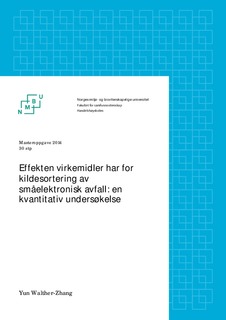| dc.description.abstract | Denne masteroppgaven har til hensikt å belyse problemet med å redusere feilkasting av småelektronisk (SE) avfall i restavfall. Innsamlingen av SE avfall via dagens returordninger fungerer ikke optimalt. Tidligere studier oppgir at rødboks-ordning og informasjon er virkemidler som påvirker kildesorteringen av SE avfall positivt. Manglende kunnskap og data skaper utfordringer i forhold til å evaluere virkemidlenes effektivitet. En spørreundersøkelse ble derfor utført for å samle inn nyttig informasjon fra husholdninger. Kildesorteringsgrad ble introdusert som indikator for å måle hvor mye av SE-avfallet som kildesorteres, samt for å teste virkemidlenes effekt på å redusere feilkasting av SE avfall. Deskriptiv statistikk ble benyttet for å beskrive dataene og undersøke virkemidlene mens økonometrisk regresjonsanalyse ble benyttet for å evaluere effekten virkemidlene har for kildesorteringsgraden.
Resultatene viser at grunnen til at SE avfall havner i restavfall skyldes at husholdninger ikke vil bruke for mye tid og innsats på kildesortering, mangel på kildesorteringstilbud og informasjon om hvordan dette avfallet skal kildesorteres, samt oppfatningen om at feilkasting ikke vil ha stor betydning for miljø. Videre viser resultatene til at både rødboks-ordning og informasjon er effektive virkemidler for kildesortering av SE avfall. Rødboks-ordningen er nyttig for å redusere feilkasting, tidsbruk og innsats forbundet med kildesorteringsaktiviteter, samt at den vil løse problemer knyttet til utilstrekkelige returordninger. Informasjon som formidler praktisk kunnskap om hvordan SE avfall kildesorteres kan påvirke adferd. Resultatene viser at husholdninger som har fått kildesorteringsinformasjon er villig til å øke innlevering av SE avfall til retur samt at de kaster mindre SE i restavfall. Det er knyttet usikkerhet til om virkemidler kan redusere den negative effekten på feilkasting av SE avfall, som følge av husholdningers oppfatning om miljøbetydning ved feilkastingen.
This master thesis aims to shed light on the problem of reducing the amount of small electrical and electronical equipment (SE) being thrown in the residual waste. The collection of SE waste through current recycling systems do not work satisfactory. Previous studies report that the "Red box arrangement" and information are instruments that affect recycling of SE waste positively. The lack of knowledge and data creates challanges related to evaluating the efficiency of policies. A survey was therefore conducted to collect useful information from households. "Waste sorting degree” was introduced as an indicator to measure how much of the SE waste that was sorted, as well as to test the instruments effect on reducing wrong sorting of SE waste. Descriptive statistics were used to describe the data and to examine the instruments, while econometric regression analysis was used to evaluate the efficiency instruments has on the waste sorting degree.
The results show that the reason SE waste ends up in the residual waste is due to households not being willing to spend to much time and effort on waste sorting/recycling, the lack of sorting offers and information about how this waste should be sorted. This, in addition to the perception that wrong sorting not will affect the environment. Furthermore, the results show that both the "red box arrangement" and information are effective instruments for recycling of SE waste. The "red box arrangement" is useful in reducing wrong sorting, time and effort related to waste sorting/recycling activities. In addition, it will solve problems related to insufficient recycling systems. Information that communicate practical knowledge on how SE waste should be sorted can affect behaviour. The results show that households who has received waste sorting/recycling information are willing to increase the submission of SE waste in addition to throwing less SE waste in the residual waste. There is uncertainty as to whether instruments can reduce the negative effect of wrong sorting of SE waste, as a result of household perceptions about the environmental impact that wrong sorting has. | nb_NO |
